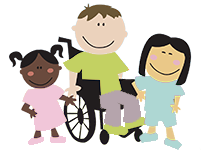AAC is short for Augmentative and Alternative Communication
Communication: “Any act by which one person gives to or receives from another person information about the person’s needs, desires, perceptions, knowledge, and affective status. Communication may be intentional, may involve conventional or unconventional signals, may take linguistic or non-linguistic forms and may occur through spoken or other modes” (National Joint Committee for the Communicative Needs of Persons with Severe Disabilities, 1992, pg. 2).
What is AAC?
Augmentative and Alternative Communication includes all forms of communication (other than oral speech) that are used to express thoughts, needs, wants and ideas. We all use AAC when we make facial expressions or gestures, use symbols or pictures, or write. People with severe speech or language problems rely on AAC to supplement existing speech or replace speech that is not functional. AAC gives people a way to communicate; it does NOT replace speech. Research states that AAC augments speech rather than inhibits speech.
What are the goals of AAC?
The primary goal of AAC systems is to facilitate individuals’ active participation and engagement in meaningful events in their daily lives. It provides individuals with the opportunity and capability to communicate messages, participate in home, school, work or community environments, learn their native language, establish and maintain social roles, and meet their personal needs.
What are the benefits of AAC?
AAC has several benefits including: improving speech intelligibility, improving an individual’s quality of life, increased health and safety, empowering the individual, increased participation in life activities, increased independence, reduced frustration, and diminished behavioral problems.
What are the different types of AAC?
There are two main types of AAC: aided and unaided. Unaided AAC does not require any additional piece of equipment and consists of gestures, body language, sign language, communication boards, and expressions. Aided AAC includes electronic devices with or without voice output (e.g., Dynavox V, Palm Talk, etc.) They allow the user to construct messages via letters, words, phrases or a variety of symbols in order to communicate.
Who benefits from AAC?
AAC is often used with individuals with developmental disabilities including Autism, Intellectual Disabilities (Mental Retardation), Developmental Apraxia of Speech, and Cerebral Palsy. It provides different communication methods for individuals who have significant speech impairments.
Helpful website’s:
C’Airey Ashurst, M.S., CCC-SLP

Comments (0)